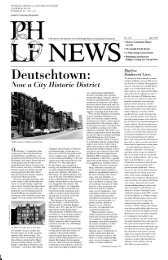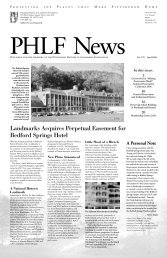Download - Pittsburgh History & Landmarks Foundation
Download - Pittsburgh History & Landmarks Foundation
Download - Pittsburgh History & Landmarks Foundation
You also want an ePaper? Increase the reach of your titles
YUMPU automatically turns print PDFs into web optimized ePapers that Google loves.
8 PHLF News February 2010 ADVOCACY COMMUNITY REVITALIZATION EASEMENTS EDUCATION & RESEARCH FARM & LANDSCAPE PRESERVATION<br />
Outcomes:<br />
Our Preservation<br />
Plans Guide Eight<br />
Historic Campuses<br />
Between 2004 and 2009, <strong>Landmarks</strong><br />
was awarded two Campus Heritage<br />
Grants from The Getty <strong>Foundation</strong><br />
and completed and published preservation<br />
planning reports for eight<br />
schools in Southwestern Pennsylvania:<br />
Allegheny College, California State<br />
University of Pennsylvania, Geneva<br />
College, Grove City College, Indiana<br />
University of Pennsylvania, Seton Hill<br />
University, Slippery<br />
Rock University,<br />
and Washington<br />
& Jefferson<br />
College.<br />
<strong>Landmarks</strong><br />
President Arthur<br />
P. Ziegler, Jr.<br />
realized that<br />
none of these<br />
schools had the<br />
individual capacity to develop historic<br />
preservation plans, so he successfully<br />
proposed to The Getty <strong>Foundation</strong><br />
that <strong>Landmarks</strong> coordinate a team of<br />
experts to assess the historic buildings<br />
and landscapes on the eight campuses<br />
and create preservation plans for each.<br />
<strong>Landmarks</strong> was the first and only<br />
preservation group in the nation to<br />
see this opportunity.<br />
The preservation plans, developed<br />
in cooperation with each school,<br />
are being used as road maps for the<br />
conservation of campus heritage,<br />
historic structures, and landscapes.<br />
James H. Mullen, Jr., president of<br />
Allegheny College, wrote the following<br />
on September 14, 2009 to Eugene<br />
Matta at <strong>Landmarks</strong>, who managed<br />
the Getty project:<br />
Thank you for the update on the<br />
<strong>Landmarks</strong>’ participation with the<br />
Society for College and University<br />
Planning and the Getty <strong>Foundation</strong> to<br />
support the dissemination of the results<br />
of the Campus Heritage Initiative.<br />
We are excited to know that Allegheny<br />
will be among the 86 campuses to<br />
appear on campusheritage.org. It will<br />
be a tremendous resource for all of us<br />
who are committed to preserving this<br />
nation’s historic campuses.<br />
The preservation plan that the<br />
<strong>Landmarks</strong>-Getty team prepared for<br />
Allegheny has been a valuable resource<br />
that continues to guide us in our<br />
decision-making. As we look ahead<br />
to the College’s bicentennial in 2015,<br />
we are grateful for the opportunity to<br />
showcase our historic campus and the<br />
treasures to be found here.<br />
The former Union National Bank Building<br />
(MacClure & Spahr, 1906) is a contributing<br />
structure in the Fourth Avenue National Register<br />
Historic District. The 21-story landmark,<br />
renamed The Carlyle, includes 61 luxury<br />
condominiums. The exterior is protected by<br />
a façade easement.<br />
Photo by B. Glenn Lewis©2010/glennlewisimages.com<br />
Ten Historic Properties Protected<br />
through Easements with <strong>Landmarks</strong><br />
The surest way to protect sites listed on<br />
the National Register of Historic Places<br />
for future generations is to donate an<br />
easement to <strong>Landmarks</strong> (see page 9,<br />
Donation Process). An easement is a<br />
voluntary legal agreement between a<br />
property owner and an authorized<br />
preservation organization to prevent<br />
unapproved alterations to the historic<br />
façade of a building, or to a historic<br />
landscape, in perpetuity. The restrictions<br />
are recorded with the deed and all future<br />
owners are bound by the restrictions.<br />
Tom Keffer, <strong>Landmarks</strong>’ property and<br />
construction manager, visits the site<br />
annually to ensure that nothing significant<br />
changes. Funds to pay for the<br />
annual inspection are donated with<br />
the easement.<br />
“Easements can provide benefits to<br />
the individual or corporate donor,” says<br />
Jack Miller, director of gift planning at<br />
<strong>Landmarks</strong>. If certain conditions are<br />
met, the donor may be entitled to claim<br />
a federal income tax charitable contribution<br />
deduction equal to the value of<br />
the preservation easement. Easements,<br />
along with federal historic rehabilitation<br />
tax credits, are useful gap-financing<br />
tools for developing historic buildings.<br />
The developers of Heinz Lofts<br />
(<strong>Pittsburgh</strong>), The Cork Factory<br />
(<strong>Pittsburgh</strong>), and Bedford Springs<br />
Resort (Bedford, PA) all donated easements<br />
to <strong>Landmarks</strong> in order to have a<br />
financially viable restoration/reuse and<br />
to preserve the architectural integrity of<br />
the National Register properties.<br />
A Skyscraper, Farm, and<br />
Historic Community<br />
In 2009, <strong>Landmarks</strong>’ Easement<br />
Committee, chaired by Duquesne<br />
University Law Professor Martha<br />
Jordan, accepted easements on:<br />
• The Carlyle (formerly the Union<br />
National Bank Building), 300 Fourth<br />
Avenue, <strong>Pittsburgh</strong>, donated by Spruce<br />
Street Properties, Ltd.;<br />
• the 136-acre Hunnell Farm in Greene<br />
County, donated by Mr. Charles Evans<br />
Hunnell; and<br />
• eight historic properties in Harmony,<br />
PA, donated by Historic Harmony, Inc.<br />
The Harmony donation is the first<br />
time <strong>Landmarks</strong> has accepted multiple<br />
easements. “What <strong>Landmarks</strong> has<br />
accomplished may well be looked<br />
upon nationally as a model for many<br />
preservation organizations,” said Bill<br />
Callahan, Western Pennsylvania<br />
community preservation specialist<br />
for the Pennsylvania Historical and<br />
Museum Commission.<br />
“We think these are the first preservation<br />
easements in Butler County,”<br />
said John Ruch, president of Historic<br />
Harmony, a nonprofit organization<br />
founded in 1943.<br />
Eight historic Harmony properties in Butler County<br />
are protected thanks to easements donated to<br />
<strong>Landmarks</strong>, including: the Bishop John Boyer<br />
House (1816), 295 Perry Highway (left and above);<br />
the Harmony Museum (1809, 1816 addition),<br />
218 Mercer Street (below left); the Wagner House<br />
Museum Annex (c. 1807–12), 222 Mercer Street<br />
(below center); and the Mennonite Meetinghouse<br />
(1825) and Cemetery (1815), 114 Wise Road.<br />
The Harmony properties are associated<br />
with the first settlement established<br />
by the Harmony Society. George Rapp,<br />
leader of the Lutheran separatists, came<br />
from Germany and founded Harmony<br />
in 1804. Their Harmony Society became<br />
19th-century America’s most successful<br />
communal group.<br />
“Historic Harmony and <strong>Landmarks</strong><br />
are to be commended for creating such a<br />
progressive and thoughtful preservation<br />
strategy for these significant properties,”<br />
said Bill.<br />
The idea of placing preservation<br />
easements on all of Historic Harmony’s<br />
properties grew from a proposal to<br />
sell the Bishop Boyer House while<br />
assuring its preservation. “The home<br />
of Harmony’s first Mennonite bishop,<br />
or pastor, was donated to Historic<br />
Harmony in 2003 by the late Lillian<br />
Frankenstein of Zelienople who<br />
entrusted its preservation to us,”<br />
John said. “We approached <strong>Landmarks</strong><br />
to explore how we could protect the<br />
house even if we no longer owned it.<br />
Jack Miller suggested using a portion of<br />
the sale proceeds to endow easements<br />
that would protect not just the Bishop<br />
Boyer House but all of our historicallysignificant<br />
properties.”<br />
“This is a win-win situation,” said<br />
<strong>Landmarks</strong> President Arthur P. Ziegler,<br />
Jr. “Historic Harmony is able to honor<br />
its commitment to its donor while<br />
generating funds to maintain its other<br />
historic buildings. We are able to assure<br />
the protection of eight architecturally<br />
and historically significant properties,<br />
and Western Pennsylvanians have<br />
guaranteed access to a tangible part<br />
of their past.”








